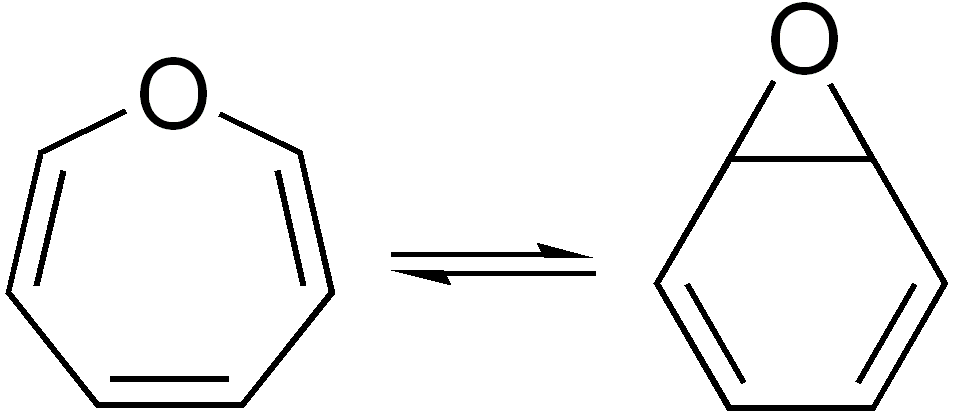Valence Isomer on:
[Wikipedia]
[Google]
[Amazon]
In
Image:Benzene-2D-flat.png,
Image:Cyclooctatetraen.svg,
Image:Naphthalene-2D-Skeletal.svg,

organic chemistry
Organic chemistry is a subdiscipline within chemistry involving the science, scientific study of the structure, properties, and reactions of organic compounds and organic matter, organic materials, i.e., matter in its various forms that contain ...
, two molecules are valence isomers when they are constitutional isomer
In chemistry, a structural isomer (or constitutional isomer in the IUPAC nomenclature) of a compound is a compound that contains the same number and type of atoms, but with a different connectivity (i.e. arrangement of bonds) between them. The ...
s that can interconvert through pericyclic reactions.
Benzene
There are many valence isomers one can draw for the C6H6 formulabenzene
Benzene is an Organic compound, organic chemical compound with the Chemical formula#Molecular formula, molecular formula C6H6. The benzene molecule is composed of six carbon atoms joined in a planar hexagonal Ring (chemistry), ring with one hyd ...
. Some were originally proposed for benzene itself before the actual structure of benzene was known. Others were later synthesized in lab. Some have been observed to isomerize to benzene, whereas others tend to undergo other reactions instead, or isomerize by ways other than pericyclic reactions.
Benzene
Benzene is an Organic compound, organic chemical compound with the Chemical formula#Molecular formula, molecular formula C6H6. The benzene molecule is composed of six carbon atoms joined in a planar hexagonal Ring (chemistry), ring with one hyd ...
Image:Historic Benzene Formulae Dewar(1867) V.1.svg, Dewar benzene
Image:Prisman2.svg, Prismane
Prismane or Ladenburg benzene is a polycyclic hydrocarbon with the formula C6H6. It is an isomer of benzene, specifically a valence isomer. Prismane is far less stable than benzene. The carbon (and hydrogen) atoms of the prismane molecule are ar ...
Image:Benzvalene.png, Benzvalene
Image:Bicycloprop-2-enyl.svg, Bicyclopropenyl
Cyclooctatetraene
The valence isomers are not restricted to isomers of benzene. Valence isomers are also seen in the series (CH)8. Due to the larger number of units, the number of possible valence isomers is also greater and at least 21:Cyclooctatetraene
1,3,5,7-Cyclooctatetraene (COT) is an unsaturated derivative of cyclooctane, with the formula C8H8. It is also known as nnulene. This polyunsaturated hydrocarbon is a colorless to light yellow flammable liquid at room temperature. Because of ...
(COT)
Image:Barrelene structure.png, Barrelene
Image:Cuban.svg, Cubane
Cubane is a synthetic hydrocarbon compound with the Chemical formula, formula . It consists of eight carbon atoms arranged at the corners of a Cube (geometry), cube, with one hydrogen atom attached to each carbon atom. A solid crystalline substanc ...
Image:Cuneane.svg, Cuneane
Image:Semibullvalene.svg, Semibullvalene
Image:1,5-dihydropentalene.png, 1,5-dihydropentalene
Image:2a,2b,4a,4b-tetrahydrocyclopropa cd pentalene.png, 2a,2b,4a,4b-Tetrahydrocyclopropa dentalene
Image:Bicyclo420octa247triene.svg, Bicyclo .2.0cta-2,4,7-triene. Tautomer
In chemistry, tautomers () are structural isomers (constitutional isomers) of chemical compounds that readily interconvert.
The chemical reaction interconverting the two is called tautomerization. This conversion commonly results from the reloca ...
with COT by thermal 6e process or photochemical 4e process
Image:Tricyclo33006octa38diene.svg, Tricyclo ,3,0,02,6cta-3,8-diene. Isomerises to semibullvalene at room temperature, stable at −60 °C
Image:Cyclobutadiene dimer cis trans.svg, Tricyclo ,2,0,02,5cta-3,7-diene. The dimer of cyclobutadiene
Cyclobutadiene is an organic compound with the formula . It is very reactive owing to its tendency to dimerize. Although the parent compound has not been isolated, some substituted derivatives are robust and a single molecule of cyclobutadiene is ...
occurs as a cis isomer and a trans isomer. Both isomers convert to COT (symmetry forbidden hence stable) with a half-life of 20 minutes at 140 °C
Image:Tetracyclooctaene.svg, Tetracyclo ,3,0,02,4,03,6octa-7-ene is only known as its 4-carbomethoxy derivative.
Image:Tetracyclooct-7-ene.svg, Tetracyclo ,2,0,02,4,03,5octa-7-ene has been prepared from benzvalene and isomerises to COT
Image:Octabisvalene.svg, Pentacyclo .1.0.02,4. 03,5.06,8ctane (octabisvalene) is the third saturated valence isomer. The (Z)-3,7-phenylsulfonyl derivative is stable up to 200 °C.
Image:Octavalene.svg, Tricyclo .1.0.02,8cta-3,5-diene (octavalene) was reported synthesised from homobenzvalene and converts to COT at 50 °C ''Electronic structure of octavalene. Photoelectron spectroscopic investigations'' Rolf Gleiter, Peter Bischof, Manfred Christl J. Org. Chem., 1986, 51 (15), pp 2895–2898
Naphthalene and azulene
Perhaps no pair of valence isomers differ more strongly in appearance than colourless naphthalene and the intensely violet azulene.Naphthalene
Naphthalene is an organic compound with formula . It is the simplest polycyclic aromatic hydrocarbon, and is a white Crystal, crystalline solid with a characteristic odor that is detectable at concentrations as low as 0.08 Parts-per notation ...
Image:Azulene-numbers.png, Azulene
Azulene is an aromatic organic compound and an isomer of naphthalene. Naphthalene is colourless, whereas azulene is dark blue. The compound is named after its colour, as "azul" is Spanish for blue. Two terpenoids, vetivazulene (4,8-dimethyl-2-i ...
Benzene oxide and oxepin

References
External links
*{{Commonscatinline Isomerism